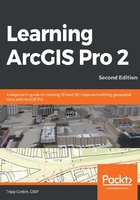
Creating 2D Maps
One of the key functions of a Geographic Information System (GIS) is to visualize data. In a GIS, we use maps as our primary method for visualizing data. Maps allow us to see and analyze the spatial relationships between features in one or more layers. We create maps for many different reasons. Often, we are trying to show the location of specific assets or to highlight attributes associated with features, such as a parcel's zoning classification or a pipe size. Sometimes we wish to show the results of the analysis we have performed.
So, each map we create in ArcGIS Pro has a reason for existing. This purpose will help to dictate what layers we include in the map and how they are visualized. There is no limit to the number of layers a map can contain. However, it is possible to have so many layers in a map that it distracts from the purpose. As the author of the map, you must strike a balance between the amount of information you include in a map and its overall purpose.
Each layer in a map has a set of properties. This includes things such as the source, symbology, visibility ranges, coordinate system and more. When you create a map and add layers, you must configure many of these settings manually to ensure your map is legible and supports its intended purpose.
As you have already experienced, ArcGIS Pro allows you to create both 2D and 3D maps within a project. In this chapter, you will focus on creating a 2D map. These have been the mainstay of GIS since it was first developed over 50 years ago. In this chapter, you will learn how to do the following:
- Creating and configuring 2D maps
- Creating a new map
- Skill challenge